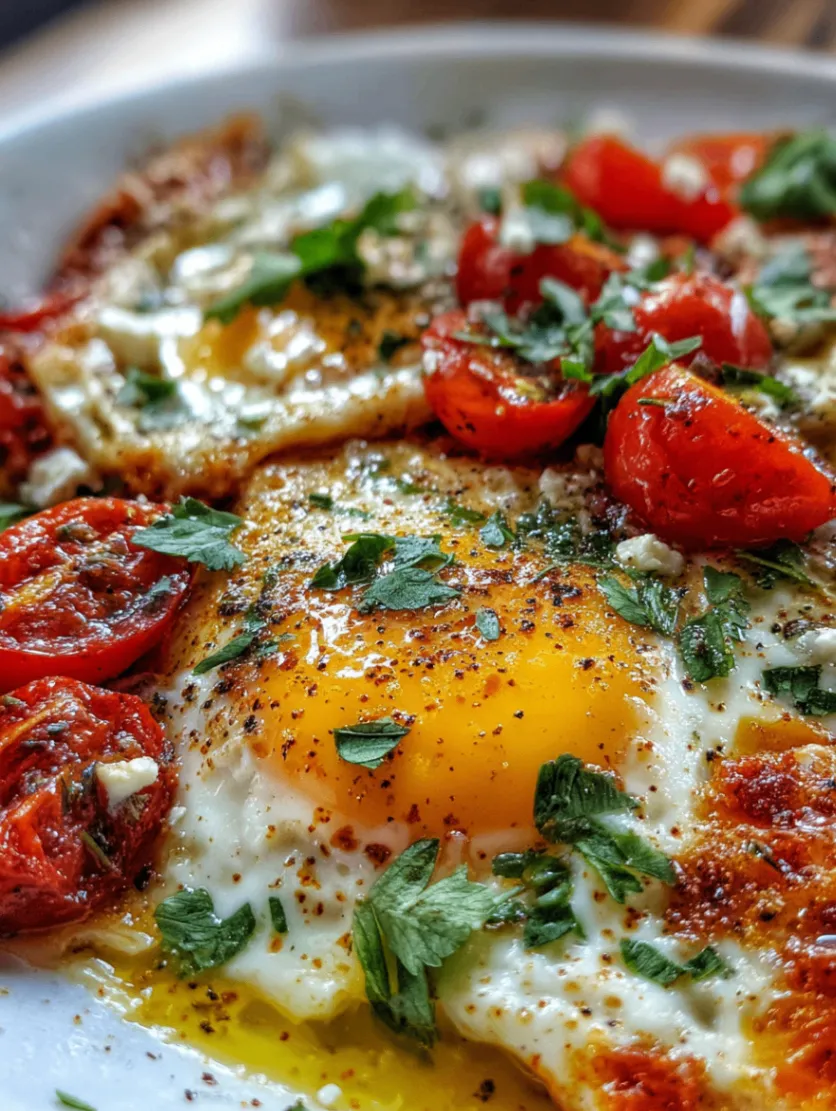Table of Contents
Let me tell you about the morning that transformed my relationship with breakfast forever. It was a lazy Sunday, and I had some leftover feta cheese from my Greek salad adventure the night before. As I stared into my nearly empty fridge, wondering what to make for brunch, inspiration struck. What if I could combine the creamy saltiness of feta with perfectly runny eggs? That’s how my obsession with baked feta eggs began.
This baked feta eggs recipe has become my go-to when I want something that feels both indulgent and effortless. There’s something magical about the way the feta melts and mingles with the silky egg yolks, creating a dish that’s greater than the sum of its parts. Whether you’re hosting friends for brunch or treating yourself to a special weekend breakfast, these baked feta eggs deliver restaurant-quality flavors with minimal fuss.
What makes this recipe so special in the culinary world is its perfect balance of simplicity and sophistication. The technique originated in Mediterranean kitchens, where cooks have long understood that the best dishes often come from combining a few high-quality ingredients and letting them shine. This baked feta eggs creation embodies that philosophy beautifully.

Baked Feta Eggs
Ingredients
Nutrition
Tried this recipe?
Let us know how it was!Ingredients: Building the Foundation of Perfect Baked Feta Eggs
The Star Players: Understanding Your Key Ingredients
The beauty of baked feta eggs lies in their simplicity, but each ingredient plays a crucial role in creating the final masterpiece. The feta cheese serves as both the base and the flavor powerhouse of this dish. When heated, it becomes gloriously creamy while maintaining its distinctive tangy bite. I always use block feta rather than pre-crumbled because it holds its shape better during baking and creates those gorgeous melted pockets we’re after.
Fresh eggs are absolutely non-negotiable for this recipe. The quality of your eggs will make or break your baked feta eggs experience. Look for eggs with bright orange yolks – they’re not only more nutritious but also create that stunning visual contrast against the white feta. When the eggs are fresh, the whites set perfectly while the yolks remain gloriously runny, creating that sauce-like consistency that makes this dish so irresistible.
The supporting cast of ingredients might seem simple, but they’re carefully chosen. Extra virgin olive oil adds richness and helps achieve that golden, bubbly top. Fresh herbs like oregano, thyme, or dill bring brightness and authenticity to the Mediterranean flavor profile. A touch of garlic powder or fresh minced garlic adds depth without overwhelming the delicate egg and cheese combination.
Selecting the Best Quality Ingredients for Superior Results
When shopping for your baked feta eggs ingredients, quality truly makes a difference. For feta cheese, seek out authentic Greek feta or high-quality Bulgarian varieties. These traditional fetas have the perfect balance of saltiness and creaminess. Avoid the ultra-processed versions that can become rubbery when heated. The good stuff should crumble easily in your hands and have a slightly briny aroma.
Egg selection is where many home cooks miss an opportunity to elevate their dish. If possible, choose pasture-raised or organic eggs from local farms. These eggs not only taste better but also have stronger shells and firmer whites, which means they’ll hold their shape beautifully when cracked into your baking dish. The deep golden yolks will make your baked feta eggs visually stunning.
Don’t overlook the importance of good olive oil in this recipe. Since it’s one of the few ingredients, using a high-quality extra virgin olive oil will significantly impact the final flavor. Look for oil with a harvest date within the past year, and choose one with a fruity, peppery finish that complements the Mediterranean theme of your baked feta eggs.

Smart Substitutions and Creative Alternatives
While traditional baked feta eggs are perfection in their simplicity, there are several substitutions you can make based on dietary needs or ingredient availability. If you can’t find good feta, goat cheese makes an excellent alternative, offering a similar tangy creaminess. Fresh mozzarella or ricotta can work in a pinch, though you’ll want to add a bit more salt to compensate for their milder flavors.
For those avoiding dairy, several plant-based feta alternatives have emerged that work surprisingly well in this recipe. Almond or cashew-based feta substitutes can be found in most health food stores. You might need to adjust the seasoning slightly, as these alternatives tend to be less salty than traditional feta.
If you’re dealing with dietary restrictions around eggs, this recipe can be adapted using egg substitutes, though the texture will be different. For a vegan version, you can create baked feta eggs using chickpea flour mixed with nutritional yeast and turmeric to mimic the egg component, though I’d recommend trying the traditional version first to understand the flavor profile you’re aiming for.
Preparation Steps: Mastering the Art of Baked Feta Eggs
Initial Prep and Essential Setup Tips
The key to successful baked feta eggs starts with proper preparation and the right equipment. Begin by preheating your oven to 400°F (200°C) – this temperature is perfect for achieving that golden, bubbly top while ensuring the eggs cook evenly. Choose individual ramekins or a small baking dish that will accommodate your feta and eggs comfortably without overcrowding.
Prepare your workspace by gathering all ingredients and having them at room temperature. This is particularly important for the eggs, as cold eggs straight from the refrigerator can crack when they hit the hot cheese and oil. Let them sit on the counter for about 15-20 minutes before you start cooking your baked feta eggs.
The most crucial prep step is properly arranging your feta in the baking vessel. Break the feta into chunks – not too small, as they’ll melt completely, but not so large that they won’t soften properly. Create little wells or spaces between the cheese chunks where your eggs can nestle. This technique ensures that each egg has its own space while still being surrounded by that creamy, melted feta goodness.
Step-by-Step Cooking Instructions with Secret Tips
Now comes the magic of creating perfect baked feta eggs. Start by drizzling your baking dish with a generous amount of olive oil – don’t be shy here, as it contributes to both flavor and texture. Arrange your feta chunks evenly across the dish, leaving spaces for your eggs. This is where my secret tip comes in: lightly drizzle the feta with a touch more olive oil and sprinkle with freshly ground black pepper before adding the eggs.
Crack each egg carefully into a small bowl first, then gently pour it into the spaces between the feta chunks. This two-step process prevents broken yolks and gives you better control over placement. The eggs should nestle naturally into the gaps, with the whites spreading slightly around the cheese. Season lightly with salt (remember, feta is already salty) and your chosen herbs.
Here’s where timing becomes crucial for perfect baked feta eggs. Bake for 12-15 minutes, depending on how runny you prefer your yolks. The whites should be just set, with perhaps a tiny bit of jiggle remaining, while the yolks should still be soft and golden. The feta will be bubbling and starting to turn golden in spots. Remove from the oven when it looks almost done – the residual heat will finish the cooking process.
Common Mistakes and How to Avoid Them
Even with a recipe as forgiving as baked feta eggs, there are several pitfalls that can derail your breakfast dreams. The most common mistake I see is overcooking the eggs. Unlike stovetop scrambled eggs, baked eggs continue cooking from residual heat even after removal from the oven. Pull them out when the whites are just barely set – they’ll finish cooking as they sit.
Temperature control is another area where home cooks often struggle. Too high heat will cause the feta to brown too quickly while leaving the egg whites undercooked. Too low, and you’ll end up with tough, rubbery eggs. Stick to that 400°F sweet spot, and trust the timing. If your oven runs hot, consider dropping the temperature to 375°F and extending the cooking time slightly.
The final mistake that can ruin your baked feta eggs is inadequate seasoning balance. Remember that feta brings significant saltiness to the dish, so taste your cheese before seasoning the eggs. Some fetas are saltier than others, and adjusting your additional salt accordingly will prevent an overly salty final product. Always err on the side of under-seasoning – you can always add more at the table.

Serving & Final Touches: Elevating Your Baked Feta Eggs Experience
Creative Presentation Ideas That Wow
The visual appeal of baked feta eggs is part of their charm, and with a few simple presentation tricks, you can make them truly Instagram-worthy. Serve them directly in their baking vessel while still hot – the bubbling cheese and runny yolks create a dramatic, rustic presentation that speaks to the dish’s Mediterranean origins. Garnish with fresh herbs just before serving; a sprinkle of chopped fresh dill, oregano, or parsley adds both color and aromatic appeal.
For individual servings, use small cast-iron skillets or ceramic ramekins. These retain heat beautifully and create an elegant, restaurant-style presentation. Drizzle a tiny bit of your finest olive oil around the edges just before serving, and add a few cherry tomato halves or thin cucumber slices for color contrast. The key is to let the baked feta eggs be the star while adding small touches that enhance their natural beauty.
Consider the table setting as part of your presentation. Warm plates, good bread for dipping, and small spoons for eating create a complete sensory experience. The contrast between the hot, creamy dish and cool, crisp bread is part of what makes baked feta eggs so satisfying. A simple white plate lets the golden and white colors of the dish shine, while rustic ceramics enhance the Mediterranean feel.
Perfect Pairings and Complementary Side Dishes
Baked feta eggs are incredibly versatile when it comes to accompaniments. The classic pairing is with crusty bread – think warm pita, focaccia, or a simple sourdough slice. The bread serves as both a vessel for scooping up the creamy mixture and a textural contrast to the soft eggs and melted cheese. Toast the bread lightly and perhaps brush with olive oil and garlic for extra flavor.
Mediterranean vegetables make excellent sides that complement the flavor profile of your baked feta eggs. Roasted cherry tomatoes, sautéed spinach, or grilled asparagus all work beautifully. The vegetables add freshness and nutritional balance to what is essentially a rich, protein-heavy dish. A simple arugula salad dressed with lemon and olive oil cuts through the richness perfectly.
For beverages, consider the meal’s rich, savory nature. A bright, acidic wine like Sauvignon Blanc or a light Pinot Grigio pairs beautifully with baked feta eggs. For non-alcoholic options, freshly squeezed orange juice or a strong cup of Greek coffee complements the Mediterranean theme. The key is choosing beverages that won’t compete with the dish but will cleanse the palate between bites.
Storage Tips and Reheating Guidelines
While baked feta eggs are best enjoyed immediately, there are times when you might have leftovers or want to prep components ahead. The dish can be stored in the refrigerator for up to 2 days, though the texture will change significantly. The eggs will continue to cook from their own heat, so they’ll be more set than when first served.
For reheating, avoid the microwave, which will turn your beautiful baked feta eggs into a rubbery mess. Instead, return them to a 300°F oven for about 5-7 minutes, just until warmed through. The texture won’t be exactly the same as fresh, but it will be much better than microwaved. Cover loosely with foil to prevent further browning.
If you want to prep ahead for entertaining, you can assemble the dish with feta and seasonings, then store covered in the refrigerator overnight. Add the eggs and bake as directed, adding a few extra minutes to account for the cold start. This technique allows you to have fresh baked feta eggs ready quickly when guests arrive, combining convenience with that just-made taste that makes this dish so special.
Frequently Asked Questions
Q: Can I make baked feta eggs in advance for meal prep? A: While baked feta eggs are best served fresh, you can prep components ahead. Arrange the feta in your baking dish and store covered in the refrigerator overnight. Add eggs and bake as directed, adding 2-3 extra minutes for the cold start. The eggs will change texture if stored after cooking, becoming more set and less creamy.
Q: What’s the best type of feta cheese for this recipe? A: Authentic Greek feta or Bulgarian feta work best for baked feta eggs. These varieties have the perfect balance of saltiness and creaminess. Avoid pre-crumbled feta, which often contains anti-caking agents that affect melting. Look for feta stored in brine for the best flavor and texture.
Q: How do I prevent my egg yolks from overcooking? A: The secret to perfect runny yolks in baked feta eggs is timing and temperature. Bake at 400°F for 12-14 minutes maximum, and remove when whites are just barely set. The eggs continue cooking from residual heat, so they’ll finish cooking as they sit.
Q: Can I add vegetables to my baked feta eggs? A: Absolutely! Cherry tomatoes, spinach, sun-dried tomatoes, or roasted red peppers all work beautifully. Add heartier vegetables like bell peppers before the eggs, and delicate greens like spinach in the last few minutes of baking to prevent overcooking.
Q: Why did my feta become rubbery instead of creamy? A: This usually happens from overcooking or using low-quality feta. Authentic feta becomes wonderfully creamy when heated, while processed versions can turn rubbery. Also, cooking at too high a temperature or for too long can cause any cheese to become tough and stringy.

Ready to Transform Your Breakfast Game?
There’s something deeply satisfying about mastering a recipe that looks complicated but is surprisingly simple. These baked feta eggs represent everything I love about cooking – the way simple ingredients can create something extraordinary when treated with care and attention. The first time you crack into that perfectly runny yolk and watch it mingle with the creamy, melted feta, you’ll understand why this dish has become such a beloved part of my recipe collection.
I encourage you to make this recipe your own. Try different herb combinations, experiment with various types of feta, or add your favorite Mediterranean vegetables. The basic technique is forgiving enough to handle creative variations, yet solid enough to deliver consistent, delicious results every time you make baked feta eggs.
Don’t forget to share your creations! Tag me in your photos and let me know what variations you tried. There’s nothing that brings me more joy than seeing how you’ve made these family favorite recipes your own. Whether you’re making them for a special Sunday brunch or a quick weeknight dinner, these baked feta eggs are sure to become a regular feature in your easy homemade recipes rotation.





